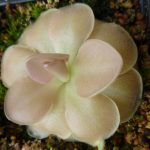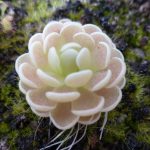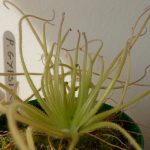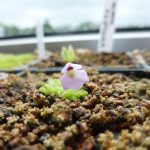When it comes to carnivorous plants, everyone knows the Venus fly trap with its snapping jaws capturing its insect prey, but there is another carnivorous species that is often overlooked that is just as deadly and perhaps even more beautiful.
The Butterworts or scientifically Pinguicula (which is a much prettier name) are plants that use their sticky leaves to entrap prey. The nutrients they receive then aid growth in their normally minerally poor growing conditions. Having a plant that dissolves its prey in juices that ooze from its skin may not be quite as dramatic as a fly trap but its still disgusting enough to impress your friends, should you have friends with a taste for the macabre!
Due to the UK’s ever changeable and often dimly lit climate, Venus fly traps or Dionea to give their scientific name tend to grow rather poorly on peoples windowsills, add in the need for rainwater and a winter dormant period and what is usually peoples first foray into carnivorous plant growing usually ends in a dead plant.
Those few species of the Southern hemisphere inhabit the deserts of South America, stretching down to Tierra de Fuego. However it is in the humid hills and canyons of Latin American and the Caribbean that Pinguicula really reach their full diversity, it is here the tropical forms thrive and new species are still being discovered.
Most of these tropical ‘Mexican’ species of Pinguicula make fun, interesting and easy to grow windowsill plants that will last and flower for large portions of the year as well as in some cases changing their leaf structure with the changing seasons. They’re usually small plants with attractive bright flowers and forgiving of lower light levels, potting mix and even water type when compared to their better know carnivorous cousins.
A good starting point is one of the common hybrids. Pinguicula x Tina (pictured below), P x Weser (also below) or P x Sethos (similar to Weser). I’ve seen those available in garden centres and certainly from growers on ebay/amazon etc. They prefer a loose mix with some organic material. They dont suit the wet peat & perlite mix you’d usually use for other carnivorous plants. That said, those ingrediants in different quantities would be fine. The first mix I used and still have plants in, largely consisted of perlite (about 80%) with some peat and a bit of sand thrown in. I’ve also used successfully a mix of Tescos ‘low dust’ kitty litter with peat added. I’m finding that a largely ‘gritty’ mix means plants grow slower but stronger. A more ‘peaty’ mix gives the opposite. I’m experimenting now with a largly gritty mix and a sprinkling of peat over the top. In short, Mexican Pings will grow in almost anything and certainly perlite/peat in about 80/20 ratio should do the job just fine.
I give them about 1.5cm of water in a tray over the summer, allow it to dry for a day or so and then repeat. These plants have a dormant winter when I give them either much less water or none at all depending on the species. For the hybrids above, they tend to stay ‘fleshy’ over the winter, but much smaller and tighter in appearance. They get a little water (again from the tray) every few weeks. Keeping them too wet in dormancy will encourage rot. For those species that form a tight ‘rosette’ in winter months no water is really needed until the spring. I water with rain or reverse osmosis water along with all my orchids and carnivorous plants. There have been reports of Mexican pings being much more forgiving of water hardness and not seeming to mind UK tap water so in a pinch I’d have no issue doing that.
If you’ve been looking for an interesting carnivorous plant to grow inside all year round in the UK, these really would be only natural choice. As mentioned above, the usual ‘issues’ can largely be avoided and they’ll even cope with grey weather if they get some sun from time to time. A south or east facing window should do fine. You may even have to shade them a little if in full sun in the height of summer. I’ve not had to do this this year due to the totally rubbish summer we’ve had however.
I’m a huge fan of these little plants and am working on propagating my existing species and hopefully bringing up a hybrid or two, so I’m sure they’ll feature in later blog posts. A few examples of my plants are below.










